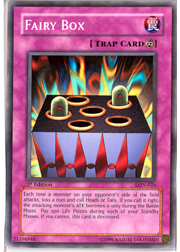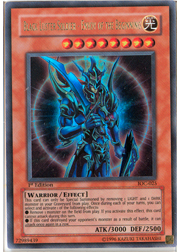A new set is coming out, so everyone is talking about the latest hot cards and what they’re going to do for the game. Naturally, you want in on this action too, but if you’re not one of the lucky ones with a lot of cash to invest in the game, what are your best options? How can you get your little slice of The Lost Millennium pie? There are smart ways to go about getting the most out of a new set, even if you’re on a tight budget, and I’m going to outline a few for you today.
Buy by the Box
First, if you want to get the most cards for your money, buy a box. “Wait!” you might be thinking. “Packs cost about four dollars—a whole box costs more like sixty!” You’re right, they do . . . but look at it on a per-pack basis. Provided you shop around for the best prices on a box, buying packs by the box can cut the pack price almost in half. If you can get the initial outlay of cash, go for a box instead of individual packs.

Okay, so you want a good price, but you want to support your local shop too, right? Those are the guys who are holding all those tournaments for you, after all. Ask the clerk at your local card store if the store would be willing to give you a deal on unopened boxes. Most shops will give you a price break on boxes, so do some math and see how the per-pack cost works out. Your best chance for extra savings is to ask early, like weeks and weeks before the product ships. Why? Because that is when the store will be pre-ordering the product. A local card store will have to estimate how much product to get, since they’re paying for it now to sell it later. If they know they’ve got a guaranteed return—in other words, you pre-ordering and paying for a box before it ships—then they probably won’t have any problem giving you a better deal, since all they have to do is increase their order from the supplier. They already have their money, so even if they make less off a pre-ordered box than a box sold after the set’s release they likely won’t care. It’s extra profit that a store owner wouldn’t otherwise have, and it costs him or her nothing. Lots of stores are willing to do this if you ask, but it does take some planning, because you’ll need to know how far in advance the store places their orders. Talk to someone who works there, and see what he or she can do for you. Bear in mind that some stores order by the case, rather than the box, so they may be less willing to order extra product. However, nothing ventured is nothing gained, so there’s no harm in asking.
Buying a box has other advantages, too. For one thing, you’ll get a better spread of rarities. A sealed box practically guarantees one ultimate rare, one ultra rare, and four or so super rares, as opposed to buying packs one or two at a time from an opened box that may have fewer foils or none at all. You’ll also usually get a better mix of rares and commons, as opposed to picking up packs here and there. Rare and common print runs generally spread more evenly in a box, so buying one box will often keep the amount of double copies of cards you receive to a minimum. If you’re a collector, that’s great! You’ll be that much closer to completing your set. If you’re a player, well, you might like to have doubles or even triples of the more playable cards, but it’s a fair trade-off for escaping a pile of identical copies of less-playable cards.
There’s one last thing to keep in mind. Don’t overlook the sheer enjoyment of opening 24 packs at one time. Trust me—if you’ve never opened a whole box worth of packs, it’s loads of fun. Go ahead and roll around in all those wrappers. No one’s watching.
Trading Off Cards You Don’t Need
If you pull a card you don’t really need for your deck, you’re usually better off trading it as soon as possible, when there are more people looking for the newer cards. Collectors will still be trying to fill in the holes in their sets, and if you start trading early enough, they’ll need regular rares in addition to the foil cards. It’s tempting to hold onto the cards, since you may wonder where they’ll end up in value, or hope to come up with an innovative way to play them. Generally speaking, though, the cards will never be as hot as when they’re fresh off the presses and new to everyone around you. In the long run, trading them off as quickly as possible will usually get you the best deals.

You’re going to need to be able to identify and trade off the “money” cards. If you do manage to get one of the big rares and don’t plan on using it in your deck, there will always be people who will want it, and be willing to trade at a premium rate. Remember
The Creator? Remember
Sacred Phoenix of Nephthys? These cards still trade incredibly well, but they traded much better upon their initial release.
In order to recognize a money card when you see it, you’ll need to learn its traits. It will usually have a distinct and cool character that appeals to collectors and kids, who drive the secondary market and create most of the demand. Second, it’s usually very playable. It might not work in every deck, but it shows serious play potential, and lots of players are talking about it. Third, they’re almost always super or ultra rares.
What are the likely starters in
The Lost Millennium? I’d say that Ancient Gear Golem will appeal to players and collectors alike, and while there aren’t very many Insect duelists out there yet, Ultimate Insect LV7 is bound to appeal to collectors. Card of Sanctity and Brain Control are also definite cards to watch for—just look how hard everyone tried to get their hands on
Lightning Vortex. The demand could vary, so talk with your local duelists and figure out the cards everyone is interested in. If you’re lucky enough to pull one and you’re on a budget, consider trading off that shiny little cash cow to get the cards you really need. You can also trade to get other tradeable cards if you can’t find what you’re looking for. If you can get to a Regional or Shonen Jump tournament, keep an eye on what decks are hot. Maybe you’ll pull some high-demand cards, and you’ll have a better idea of their value if you know what will see play in the current environment.
Choose Your Targets
Knowing what you’re looking for ahead of time is more efficient than cracking open a box and shuffling through the contents with no real knowledge of the set. Use whatever resources you have to study the set as early as possible, so you can make up your mind as to what you’re gunning for. This can help you gauge trade and purchase decisions. If you don’t think you really need anything from a set, pick up a box anyway! The trade value alone of new material when a set is released will make it a worthwhile purchase. Whether you’re a collector looking to complete the set, a player looking for key cards for your deck, or just a trader looking for hot new stock to give you an edge, identify your priorities and learn what’s going to bring the biggest return.

You don’t want to cater only to collectors, so you need to know the metagame. Rock, Insect, Warrior, Chaos, Machine, and Spellcaster decks will all get a boost from
The Lost Millennium, so popularity may rise for those types of decks. Elemental Hero decks will generate a lot of interest among some duelists, and since all the cards are new, it’s unclear as to how popular they may prove to be once the set has been out for a while. Cards that can fit into nearly every deck, like Brain Control, are quite solid, but knowing what kinds of cards are likely to be in demand in your area will greatly improve your chances of making a profitable trade.
Play Sealed Pack Events
Sealed Pack events are a great place to get new cards. Most events won’t charge you any more than the price of the packs themselves. In return, you’ll get to meet plenty of people who will also have new cards (and may be willing to trade them after the event is over) and you also get a shot at winning more product! If you’re attending a Sneak Preview event and you show up early enough, then you can get exclusive promo cards that also trade incredibly well.
Playing in Sealed Pack events is also a fun way to get more practical experience with the new cards, so consider them a low-cost fast track to important knowledge about the new set. The information you gather in Sealed Pack and Booster Draft play may help you set your priorities. The added influx of players—many, many more than you will see in hobby leagues and local shops—will all give you an expanded idea of the value of the cards. Plus, they’ll have trade binders you haven’t already looked through a dozen times.
Duelists who haven’t secured their spot at Nationals have their work cut out for them, especially now that Regional tournaments are winding down. It can be hard to build a tournament-class deck on a budget, and trading smart is one way to accomplish that. The payoffs from Yu-Gi-Oh! Organized Play have never been more tempting, and smart use of your money and trading can help you claim your share.